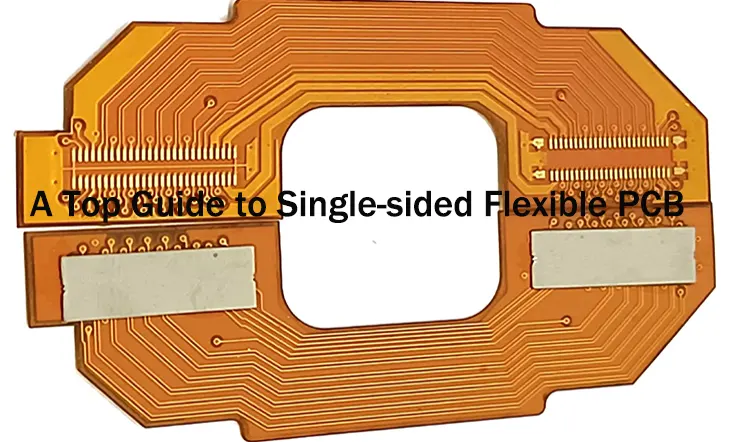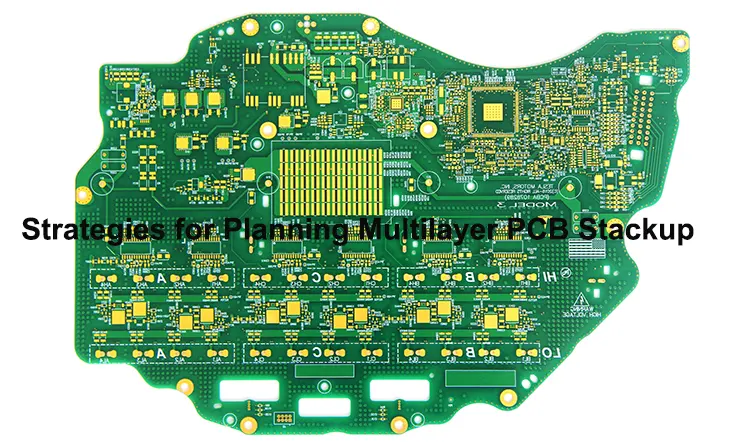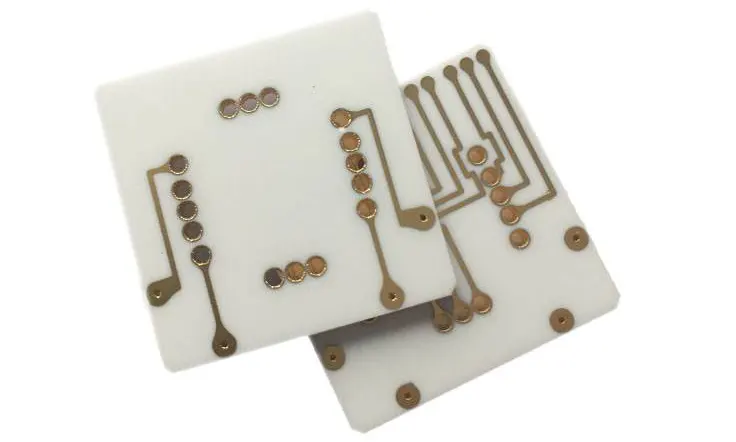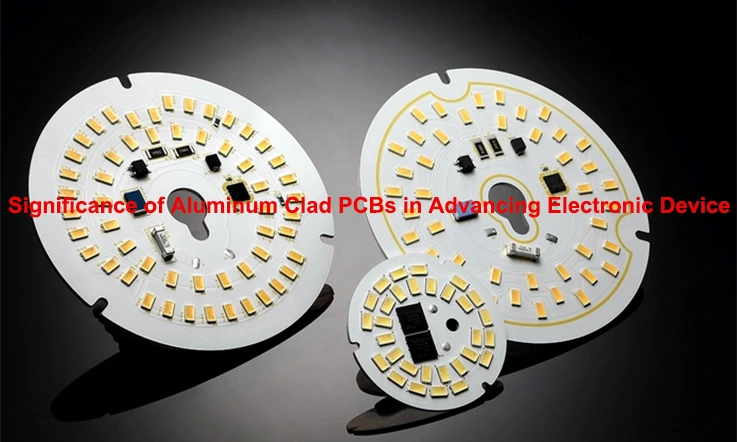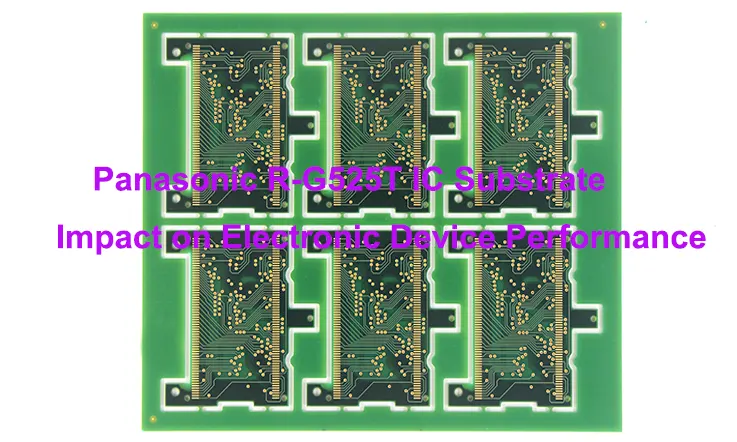
Panasonic R-G525T is engineered to meet the demands of high-density, high-frequency, and thermally challenging electronic environments. This material supports fine-pitch IC packaging, HDI PCB builds, and high-reliability use in automotive and 5G infrastructure. Through comprehensive evaluation, this guide explores its performance in areas such as via-in-pad design, build-up layer processing, signal integrity, EMI control, thermal management, and environmental durability. Also included are comparisons with other Panasonic laminates, qualification standards, and manufacturing insights to assist in substrate selection and deployment across complex systems.
What is Panasonic R-G525T IC Substrate and Why It Matters in PCB Manufacturing?
Printed circuit board (PCB) development has come a long way, especially in industries where performance hinges on electrical stability and mechanical consistency. The Panasonic R-G525T IC substrate brings together several performance characteristics that match the demands of industries like telecommunications, automotive systems, and next-gen wireless tech. This material has been developed to meet conditions that push conventional substrates beyond their capabilities — and it does so with consistency and predictability.
Introduction to Panasonic R-G525T IC Substrate Resin System
Panasonic’s R-G525T incorporates a glass cloth-reinforced BT (bismaleimide triazine) resin system. This formulation provides a stable dielectric response and reliable thermal resistance, supporting applications that involve repeated thermal cycling and elevated signal transmission rates. Its molecular structure and reinforcement design offer controlled expansion characteristics and low signal attenuation, which makes it suitable for high-frequency and temperature-variable operating conditions.
| Feature | Spec Value | Functional Use Case |
| Dielectric Constant (1GHz) | ~4.3 | Stable impedance in high-speed signal lines |
| Dissipation Factor (1GHz) | ~0.015 | Low signal loss, better energy efficiency |
| Tg (Glass Transition Temp) | ~270°C | Heat resilience during assembly and operation |
| Z-axis CTE | ~3–5 ppm/°C | Reduced delamination under repeated heating cycles |
| Peel Strength | ~0.6 kN/m | Robust copper adhesion during thermal stress |
This resin system helps human manage trace routing, via alignment, and reflow conditions without fear of board deformation or data loss. If your stack-ups need to handle heat and hustle, this material has your back.
Key Attributes for IC Substrate PCB Manufacturing Services
For OEMs and contract manufacturers handling high-density, multilayer substrates, R-G525T offers several production-friendly characteristics:
●Laser Via Support: Compatible with UV and CO₂ laser processing, giving engineers flexibility in via diameters and placements.
●Stable Lamination Flow: Simplifies multi-lamination cycles, a must for high-layer count HDI stack-ups.
●Environmental Tolerance: Low moisture absorption ensures dimension stability in humid or sealed environments.
This material is compatible with via-in-pad plating, sequential lamination processes, and surface finishes such as ENIG or OSP. For applications ranging from RF filter tuning to 8-layer-and-above IC substrate configurations, it demonstrates stable behavior throughout standard and advanced fabrication environments.
Support for Advanced Multilayer and High-Density Interconnect PCBs
In multilayer and HDI designs, substrates must perform under tight mechanical tolerances. The R-G525T addresses this through:
●Fine Pitch Design Compatibility: Keeps trace impedance under control at small geometries without inducing signal noise.
●Sequential Build Readiness: Maintains mechanical alignment through stacked and staggered via configurations.
●High Thermal Conductivity: Aids in the dissipation of localized heat in power delivery zones or signal switch cores.
Let’s say you’re building a 5G antenna module. This substrate offers the kind of layer stack uniformity and signal clarity that’s hard to get from standard FR-4 or mid-tier resin systems. Engineers we’ve worked with have used it in modules operating between 20–40 GHz with performance data that aligns tightly with simulation outputs — a rare win in production validation.
Electrical and Thermal Properties of Panasonic R-G525T PCB Laminates
In advanced multilayer circuit design, understanding the electrical and thermal response of substrate materials directly affects stack-up decisions and packaging compatibility. Panasonic R-G525T is formulated to support performance stability under high-frequency signaling environments and thermomechanical demands typical of flip chip and high-layer-count PCBs. The following sections examine its electromagnetic behavior, thermal endurance, and mechanical response with respect to PCB design and fabrication.
Dielectric Constant and Loss Tangent for Signal Integrity
For circuit performance above 1 GHz, material selection is directly influenced by its dielectric constant and dissipation factor. Panasonic R-G525T features:
●Dielectric constant (Dk) near 4.3 measured at 1 GHz, which facilitates predictable signal delay characteristics across interconnects.
●Dissipation factor (Df) around 0.015 at the same frequency, supporting low insertion loss across transmission lines.
These values support the development of low-loss channels in environments where edge-coupled differential pairs, impedance control, and crosstalk management are required, such as in mmWave antenna feedlines and high-speed serializer-deserializer (SerDes) circuits.
Moreover, the stable Dk across a range of temperatures and humidity levels helps maintain simulation accuracy during design iterations, reducing impedance mismatches during fabrication.
High Glass Transition Temperature and Thermal Reliability
Glass transition temperature (Tg) defines the onset of thermomechanical softening in resin systems. Panasonic R-G525T demonstrates:
●Tg exceeding 260°C (DMA method), suitable for lead-free reflow and high-temperature soldering cycles.
●Retention of structural integrity across thermal excursions, minimizing dimensional deviation between reflow passes and thermal cycling.
In practical applications, this allows us to implement double reflow assembly processes or BGA underfill operations without concern for resin brittleness or interlayer delamination. Automotive under-the-hood environments or RF modules with continuous power loading also benefit from this level of thermal endurance.
Additionally, this thermal characteristic enables compatibility with halogen-free solder masks and high-temperature-compatible prepregs, expanding material selection freedom across the stack-up.
Low CTE for Warpage Control in Flip Chip Packages
Coefficient of thermal expansion (CTE) is a determining factor when evaluating compatibility with semiconductor dies and encapsulants. R-G525T exhibits:
●In-plane (X-Y axis) CTE values typically in the 3 to 5 ppm/°C range, supporting dimensional stability during rapid thermal transitions.
●Mechanical modulus behavior that maintains rigidity below Tg and offers controlled flex compliance beyond Tg, helping reduce delamination risk.
In flip chip BGA packages, warpage between silicon and organic substrate can create open connections or mechanical stress at solder joints. R-G525T’s balanced thermal response helps avoid such failure modes during reflow or temperature cycling. This benefit is particularly observable in advanced package-on-package (PoP) designs, where warpage stacking can otherwise become a limiting factor.
For applications requiring precise control over package height, ball pitch, and redistribution layer (RDL) uniformity, the low CTE behavior of this material supports stable results in thermo-mechanical simulations and downstream assembly validation processes.
Panasonic R-G525T in Automotive Electronics and ADAS PCB Design

The advancement of automotive electronics demands substrate materials that can operate steadily across a broad temperature range, withstanding continuous exposure to vibration, moisture, and thermal cycling. Panasonic R-G525T IC substrate material has been engineered to address the specific conditions found in electronic control units (ECUs), radar modules, and other ADAS components. Its resin system and structural composition offer controlled dielectric performance, dimensional stability, and robust interconnect integrity. The following sections detail how this laminate meets the evolving requirements of automotive environments.
Performance in High-Temperature and Harsh Environments
Panasonic R-G525T’s resin matrix and glass cloth reinforcement make it suitable for integration into applications subject to aggressive environmental stress. The following material behaviors help maintain stable electrical and mechanical characteristics throughout extended operating periods:
●Glass Transition Temperature (Tg): R-G525T supports operation above 185°C (DSC), enabling deployment near engine compartments and powertrain zones.
●Thermal Decomposition Temperature (Td): Maintains structure beyond 360°C (TGA), reducing resin recession risk during reflow or wave soldering.
●Moisture Resistance: Exhibits low moisture absorption (below 0.1%), maintaining insulation and signal quality in humid environments.
●Thermal Shock Performance: Withstands -40°C to +150°C cycling without delamination, suitable for locations exposed to rapid climate changes.
●High CTI (Comparative Tracking Index): Enhances surface reliability against ionic contamination, especially in condensation-prone automotive assemblies.
| Performance Metric | Value | Test Method |
| Glass Transition Temperature (Tg) | > 185°C (DSC) | Differential Scanning Calorimetry |
| Thermal Decomposition Temperature (Td) | > 360°C | Thermogravimetric Analysis (TGA) |
| Moisture Absorption | < 0.1% | IPC-TM-650 2.6.2.1 |
| Thermal Shock Range | -40°C to +150°C | IPC-TM-650 2.6.7.2 |
| Comparative Tracking Index (CTI) | > 600V | IEC 60112 |
These characteristics enable R-G525T to maintain reliability in applications near engines, HVAC systems, or exterior-mounted sensor modules.
Integration into ECU, Power Modules, and Radar PCBs
Panasonic R-G525T’s compatibility with high-frequency and power electronic applications allows it to be used across a diverse range of automotive subsystems:
●Electronic Control Units (ECUs): Enables signal clarity and thermal performance in multilayer HDI designs for powertrain, chassis, and infotainment ECUs.
●Power Modules: Low Z-axis expansion and reliable thermal pathways make R-G525T suitable for gate driver boards and power inverter interface layers.
●Radar and Sensor PCBs: The low dissipation factor (Df < 0.003 @10 GHz) ensures minimal signal distortion in 77 GHz radar systems for adaptive cruise control and blind-spot monitoring.
●Flexible-to-Rigid Transitions: Maintains interfacial reliability where flex-rigid junctions are integrated in space-saving form factors.
●Solder Joint Durability: Provides stable Cu-foil adhesion under thermal aging, supporting robust I/O connections in dense SMT layouts.
| Application Area | R-G525T Benefit | Technical Detail |
| ECUs | Signal integrity & heat tolerance in HDI designs | Tg > 185°C, low Df, low CTE |
| Power Modules | Dimensional stability & Z-axis thermal reliability | Z-axis CTE < 45 ppm/°C |
| Radar Systems | Low signal loss at mmWave frequencies | Df < 0.003 @ 10 GHz |
| Flex-to-Rigid Assemblies | Mechanical strength at interfacial zones | High peel strength > 1.0 N/mm |
| SMT Solder Joints | Long-term adhesion under thermal stress | Copper peel after aging: > 0.8 N/mm |
This adaptability improves design latitude for Tier-1 automotive PCB developers aiming to miniaturize and densify ADAS modules.
Automotive-Grade Certification and Reliability Testing
Compliance with industry-standard certifications and qualification benchmarks reinforces R-G525T’s credibility across global automotive supply chains. The laminate system has been validated through rigorous performance protocols, such as:
●AEC-Q200 Compliance (Test Items for Passive Components): Meets thermal aging, vibration, and mechanical shock criteria for vehicle-grade electronics.
●IPC-4101/126 Conformity: Fulfills requirements for high-performance substrates with consistent dielectric and mechanical properties across production lots.
●CAF Resistance: Demonstrates electrochemical insulation retention under high humidity and bias voltage, minimizing failures in via holes and fine-pitch traces.
●Flammability Rating (UL 94 V-0): Ensures minimal flame propagation risk, relevant for enclosures with limited ventilation or plastic overmolding.
●SIR Stability (Surface Insulation Resistance): Maintains insulation integrity post-reflow and under continuous bias, even at elevated temperatures.
| Certification/Test | R-G525T Status | Relevance |
| AEC-Q200 | Passed (Thermal aging, vibration, shock) | Qualification for passive components in vehicles |
| IPC-4101/126 | Compliant | Meets high-performance substrate specs |
| CAF Resistance | Pass (≥ 1000 hrs @85°C/85% RH, 10 V) | Reliability of fine traces and vias |
| Flammability (UL 94) | V-0 Rating | Flame-retardant material suitable for enclosed spaces |
| Surface Insulation Resistance (SIR) | > 10⁹ Ω after reflow @85°C/85%RH | Ensures post-reflow electrical isolation |
These benchmarks affirm R-G525T’s readiness for deployment in mass-market and mission-critical automotive platforms.
Advanced 5G and IoT PCB Applications Using Panasonic R-G525T
The Panasonic R-G525T IC substrate material demonstrates a strong alignment with technical demands in 5G and IoT hardware. With increasing layout complexity, compact integration, and high-frequency requirements, this substrate enables stable electrical and thermal performance across a range of embedded applications. Below, we explore how this material aligns with specific hardware functions in mmWave, antenna modules, and miniaturized consumer electronics.
mmWave Compatibility and RF Signal Performance
When designing for millimeter-wave (mmWave) frequency bands, consistent signal behavior over a wide range of frequencies is required. Panasonic R-G525T meets these specifications by offering:
●Dielectric constant (Dk) stability across 10–40 GHz range
●Loss tangent (Df) values below 0.0025 at 10 GHz, supporting reduced signal distortion
●Fine-pitch capability down to ≤20 µm line/space, supporting high-density RF layouts
●Uniform copper foil adhesion under high-frequency etching conditions
This profile fits base station transceivers, phased array modules, and short-range mmWave sensor integration with minimal impedance deviation or phase noise drift.
5G Antenna-in-Package and Front-End Modules
Integration of antenna structures within IC substrate layers streamlines the overall profile of 5G front-end modules (FEM). Panasonic R-G525T contributes to these systems through:
●Support for multi-layered HDI buildup for embedded passive and active elements
●Low Z-axis expansion, promoting dimensional alignment in antenna cavity etching
●High glass transition temperature (Tg > 250°C) enabling reflow solder compatibility
●Dimensional control under FCCSP and SiP packaging for enhanced RF shielding
Use of this substrate is observed in 5G mmWave beamforming units and mid-band FEMs where tight RF performance and material tolerance margins are required.
Use in Wearables, Smart Devices, and IoT Gateways
For compact consumer electronics and IoT gateways, the Panasonic R-G525T provides predictable performance in compact multilayer assemblies. Key design contributions include:
●Consistent impedance across temperature cycles in wearable form factors
●Low moisture absorption (<0.1%), protecting RF stability in high-humidity usage
●Multi-board compatibility for edge devices with embedded sensors and BLE/5G transceivers
●Lightweight laminate composition that accommodates ergonomic housing structures
So, whether targeting AR headsets, AI-enabled voice assistants, or edge computing terminals, this substrate supports advanced circuit design without loss in layout flexibility or RF predictability.
Flip Chip, BGA, and CSP Packaging on R-G525T IC Substrate

As semiconductor integration density rises and package footprints shrink, substrate materials must deliver stable electrical, thermal, and mechanical behavior across various packaging formats. Panasonic R-G525T IC Substrate provides a resin system optimized for multilayer redistribution and micro-interconnect stability, especially in flip chip, ball grid array (BGA), and chip-scale packaging (CSP) applications. This section outlines packaging-specific design factors, mechanical stacking approaches, and reliability controls needed for fabrication environments involving Panasonic R-G525T IC Substrate PCB manufacturing.
Via-in-Pad Design Considerations for Fine-Pitch Layouts
Via-in-pad structures have become standard for flip chip and BGA designs targeting fine-pitch geometries under 0.4 mm. With Panasonic R-G525T IC Substrate, the resin’s compatibility with advanced via filling and planarization processes supports high-density interconnects in complex PCB stacks. Several aspects deserve focused attention:
●Via-in-pad copper plating: The filled via structures using electroless and electrolytic plating show uniform deposition when paired with R-G525T’s controlled resin shrinkage behavior.
●Resin smear removal: Laser-drilled via pads exhibit minimal smear, reducing the need for aggressive desmear chemistry and enhancing interlayer adhesion.
●Solder mask registration: Fine features benefit from R-G525T’s surface smoothness, promoting accurate solder mask alignment in fine-pitch arrays.
Such factors streamline Panasonic R-G525T IC Substrate PCB design when building miniaturized components, including microcontrollers, radar transceivers, and ASICs deployed in automotive or telecom systems.
Build-Up Layer Techniques and Solder Joint Integrity
Modern flip chip and CSP packaging depend on microvia-based build-up layers and multilayer redistribution structures to reroute signals across dense I/O interfaces. Panasonic R-G525T IC Substrate’s compatibility with semi-additive processes (SAP) and modified semi-additive processes (mSAP) makes it particularly effective for supporting these architectures. Key attributes include:
●Dielectric integrity during thermal reflow: The substrate maintains layer adhesion and dimensional stability through lead-free solder reflow profiles exceeding 260°C.
●Coefficient of thermal expansion (CTE) alignment: Mechanical behavior closely tracks silicon chip CTE, helping maintain joint continuity under cyclic thermal conditions.
●Copper trace line/space resolution: Sub-25 µm L/S performance is achievable in conjunction with dry-film photoresists, particularly for CSP formats with large I/O counts.
These properties contribute directly to long-term reliability in Panasonic R-G525T IC Substrate PCB manufacturing services focused on low-defect yield rates.
Reliability in Fan-Out and Wafer-Level Packaging
Emerging package formats such as fan-out wafer-level packaging (FO-WLP) and embedded wafer-level ball grid arrays (eWLB) extend traditional packaging approaches beyond laminate-based redistribution. Even in these formats, Panasonic R-G525T IC Substrate demonstrates mechanical compatibility and structural durability. Notable performance indicators:
●Thermo-mechanical cycling endurance: Tests simulating 500+ thermal shock cycles (−40°C to 125°C) demonstrate minimal delamination or pad lift-off.
●Moisture sensitivity levels (MSL): Laminates fabricated with R-G525T meet MSL 2 requirements after 168-hour 85°C/85%RH exposure, supporting automotive-grade reliability thresholds.
●Void mitigation under bump areas: The glass cloth and resin composition limits gas generation during cure, reducing potential for voiding in underfill processes or bump reflow.
Panasonic R-G525T IC Substrate supports integration across automotive microprocessors, 5G modem chipsets, and AI acceleration modules—all requiring stability over wide temperature and vibration ranges.
Stack-Up Strategies and Signal Integrity with Panasonic R-G525T
Achieving stable signal transmission and minimizing electromagnetic interference remain central concerns in advanced IC substrate PCB design. Panasonic R-G525T’s resin system supports high-frequency, multi-layer applications, making it suitable for packages requiring low transmission loss, controlled impedance, and dense vertical interconnects. With appropriate layer configuration and material selection, performance and manufacturability can be balanced effectively in next-generation electronic systems.
EMI Shielding and Differential Pair Impedance Control
Minimizing electromagnetic interference (EMI) and maintaining signal integrity in high-speed circuit designs require precise layout techniques and careful selection of material characteristics.
●Ground Plane Integration: Establishing continuous ground planes next to signal layers offers low-impedance return paths, which help reduce loop areas and lower EMI emissions.
●Differential Pair Routing: Keeping consistent spacing and length matching between differential pairs supports uniform impedance and reduces common-mode noise generation.
●Controlled Impedance:Adjusting trace widths and dielectric thickness to meet specific impedance targets (such as 100 Ω for differential pairs) directly influences signal quality preservation, especially in high-speed interconnects where impedance mismatches can lead to reflection, loss, and timing errors.
●Material Selection: Employing substrate materials like Panasonic R-G525T, which feature low dielectric constants, contributes to reaching targeted impedance values and decreases signal attenuation during transmission.
Applying these principles supports effective EMI control and signal fidelity preservation throughout complex multilayer PCB architectures.
Core vs Coreless Structures for High-Speed PCBs
The use of coreless constructions is growing in substrate-based IC packaging, particularly where finer pitches and increased I/O density are required. Panasonic R-G525T adapts well to both core and coreless schemes due to its mechanical stability and low CTE.
●In coreless designs, R-G525T enables uniform via distribution and thin dielectric spacing, supporting 10–15 μm laser via formation.
●Mechanical rigidity remains sufficient for warpage suppression in large-die flip-chip packages.
●Compatible with semi-additive processes (SAP), facilitating <10 μm L/S and fine-pitch redistribution layers.
●Core-based builds still benefit from low Z-axis expansion, minimizing risk in back-grind and dicing steps.
| Structure Type | Feature Enabled by R-G525T | Metric/Capability |
| Coreless | Thin dielectric stack-ups | Laminate thickness down to 35 µm |
| Coreless | High-density laser vias | Laser via pitch: 10–15 µm |
| Coreless | SAP-compatible fine lines | Line/Space resolution: <10 µm / <10 µm |
| Core-based | Warpage and back-grind resistance | Z-axis CTE: <26 ppm/°C (below Tg) |
| General | Flip-chip package mechanical stability | Warpage < 50 µm (on 100 mm panel) |
Choose between core or coreless depending on application demands such as panel utilization, cost tolerance, and yield control. R-G525T supports both paths without compromise in reliability.
Embedded Passive Elements and Power Distribution Optimization
As signal layers increase and surface area shrinks, integrating passive components within the stack-up becomes increasingly effective. Panasonic R-G525T supports this through its dimensional stability and resin flow control during lamination.
●Uniform lamination flow maintains predictable dielectric thickness between embedded resistors and signal traces.
●Low Z-axis CTE (<26 ppm/°C below Tg) prevents via misalignment across build-up layers.
●Stable glass transition temperature (~190°C) avoids delamination under reflow and thermal cycling conditions.
●Enhanced power integrity (PI) through decoupling capacitors directly embedded beneath core power rails.
| Embedded Element Role | Material Benefit from R-G525T | Parameter Value |
| Embedded Resistors | Uniform lamination flow | Flow deviation < ±3% during press cycle |
| Via Alignment Across Build-Up | Low Z-axis thermal expansion | <26 ppm/°C (below Tg) |
| Solder Reflow Robustness | Stable Tg for layer bond strength | Tg ≈ 190°C (DSC) |
| Embedded Decoupling Capacitors | High stability for PI layer optimization | Capacitance loss <5% post reflow |
| Total Stack-Up Reliability | Delamination and CAF resistance | No delam/corrosion @85°C/85%RH, 1000 hrs |
This methodology reduces inductive noise, stabilizes supply rails, and minimizes PCB real estate consumption—reliable for wearable devices, compact IoT modules, and RF system-in-package designs.
HDI and Multilayer PCB Manufacturing Services for Panasonic R-G525T

Manufacturing HDI and multilayer PCBs with Panasonic R-G525T involves precise control of fabrication processes to meet the demands of modern electronics. The material characteristics combined with advanced production techniques contribute to consistent electrical performance and mechanical reliability. The sections below focus on specific manufacturing factors such as microvia drilling, laminate flow during lamination, laser ablation for fine features, and compatibility with surface finishes and solder masks. Grasping these elements supports achieving the desired PCB quality and functionality.
Microvia Drilling Parameters and Plating Quality
Microvias serve as core conduits for electrical signals within compact multilayer boards, demanding exact drilling and plating methods to maintain circuit integrity.
●Microvia dimensions such as diameter and depth are precisely regulated to reduce the risk of voids and incomplete plating.
●Laser parameters are optimized to control heat input and minimize damage to surrounding materials, preserving substrate structure.
●Copper plating thickness along microvia walls is consistently maintained, contributing to reduced electrical resistance and enhanced mechanical strength.
●Performance data indicates that microvias produced under controlled conditions in R-G525T maintain electrical continuity and withstand thermal stress in demanding applications.
Laminate Flow Control and Laser Ablation for Fine Features
The flow behavior of resin during lamination directly affects the integrity of HDI stack-ups, while laser ablation techniques enable the creation of intricate circuit features essential for high-density designs.
●Monitoring and adjusting lamination temperature and pressure profiles help regulate resin viscosity, preventing delamination or void formation.
●Uniform resin flow maintains dimensional stability of fine copper traces and build-up layers throughout the multilayer stack.
●Laser ablation parameters are fine-tuned to precisely remove dielectric layers, enabling feature sizes that meet the demands of modern high-frequency circuits.
●Controlled laser processing minimizes micro-cracks and maintains substrate integrity, which supports signal performance and mechanical reliability.
Surface Finish Compatibility and Solder Mask Guidelines
Surface finishing and solder mask application are steps that influence both assembly processes and long-term durability of PCBs manufactured with R-G525T materials.
●Compatibility between the laminate and surface finishes such as ENIG, HASL, and OSP is evaluated based on thermal and chemical interaction during soldering.
●Adhesion between solder mask and substrate is enhanced through tailored surface preparation techniques to prevent mask lifting or contamination.
●Solder mask formulations are selected to resist cracking or peeling under thermal cycling and mechanical stress during assembly.
●Empirical observations confirm that optimized solder mask processes reduce solder bridging and defects in fine-pitch component soldering.
Thermal Management and Heat Dissipation in Panasonic R-G525T-Based PCBs
Thermal management impacts performance and longevity of PCBs made with Panasonic R-G525T. The material’s thermal conductivity, mechanical strength, and stability under temperature cycles influence heat transfer strategies, power delivery design, and reliability assessments for advanced PCB applications.
Integration into Power Delivery Networks and High-Current Paths
Effective heat transfer in power delivery circuits involves multiple design considerations influenced by the PCB material and layout.
Copper Thickness and Trace Design-
●Increasing copper thickness reduces electrical resistance, lowering heat generation along high-current routes.
●Wider traces help spread current flow and prevent localized temperature rises.
Via Arrays and Thermal Conductivity-
●Plated through via arrays facilitate heat conduction between internal layers and external heat sinks.
●High via density is supported by R-G525T’s structural properties, enabling improved vertical heat dissipation.
Temperature Cycling and Material Stability-
●R-G525T maintains stable electrical and mechanical behavior after repeated thermal cycling.
●Low moisture absorption assists in preserving insulation performance during temperature changes.
Heat Spreaders and Embedded Cooling Structures
Techniques to extend heat removal surfaces and embed cooling pathways complement the base PCB material properties.
Metal Core Heat Spreaders-
●Heat spreaders attached beneath the PCB create larger surfaces for heat release.
●Compatibility between R-G525T laminates and metal cores influences thermal transfer efficiency.
Embedded Cooling Channels-
●Microchannels integrated within layers allow for liquid or air cooling near heat-generating components.
●Material expansion rates must be considered to avoid structural issues.
Thermally Conductive Fillers-
●Incorporation of ceramic or graphite fillers enhances overall thermal conductivity.
●R-G525T formulation accommodates filler inclusion without sacrificing electrical insulation.
Thermal Simulation and Reliability Metrics
Simulation and testing complement each other in evaluating thermal performance before full production.
Finite Element Thermal Modeling-
●Using R-G525T’s thermal properties, simulations map heat distribution and identify hotspots.
●Stack-up configurations and via placements are optimized based on thermal flow analysis.
Thermal Stress and Fatigue Testing-
●Accelerated thermal cycling tests correlate with simulation data to evaluate material durability.
● Resistance to thermal shock reduces risks of mechanical failure.
Performance Validation through Testing-
●Prototype PCBs undergo stress tests simulating real-use conditions to confirm thermal management effectiveness.
●Testing outcomes support ongoing design improvements for heat dissipation.
Moisture Absorption, CAF Resistance, and Environmental Reliability

As the density of PCB interconnects scales up, so does the exposure to environmental degradation mechanisms. In sectors such as 5G outdoor infrastructure, EV control units, and aerospace radar arrays, long-term operation is often accompanied by thermal shock, humidity cycling, and electrical bias—factors that challenge the electrochemical integrity of any laminate.
Panasonic’s R-G525T is formulated to counteract moisture penetration and conductive filament propagation while supporting structural cohesion in multi-layered systems. Let’s break down how these characteristics translate to practical resilience.
Moisture Diffusion Control in High-Layer Boards
In HDI systems exceeding 10 layers, moisture ingression becomes increasingly difficult to manage. Entrapped vapor can lead to delamination, via cracking, and popcorning during reflow soldering.
Resin Matrix Stability-
The thermoset base of R-G525T limits water molecule diffusion due to its dense crosslink density. Water absorption rate measured per IPC-TM-650 2.6.2 is <0.10% after 24-hour immersion, demonstrating reduced hygroscopic expansion.
Glass Fabric and Weave Influence-
By using low-Dk E-glass with minimized open weave regions, capillary moisture movement is reduced. The silane treatment enhances fiber-matrix bonding, disrupting moisture propagation paths.
Preconditioning and Bake-Out Behavior-
R-G525T exhibits minimal thickness expansion (<0.6%) even after preconditioning at 85°C/85%RH for 168 hours. Thermal bake at 125°C for 4 hours further reduces absorbed water without causing fiber blooming or surface crazing.
Suggested Bake Protocols-
Before BGA assembly or underfill processes:
●120°C x 4 hrs (recommended)
●100°C x 6 hrs (alternative)
Use forced convection for uniformity and ensure part spacing to maximize airflow.
Conductive Anodic Filament (CAF) Suppression Techniques
CAF growth stems from electrochemical migration of copper along the glass-resin interface under DC bias and humidity. Left unchecked, it causes dielectric breakdown and latent shorts in fine-line PCBs.
Resin-Fiber Interface Engineering-
The epoxy system in R-G525T leverages high coupling strength at the glass interface, forming a barrier against ion mobility. Cross-sectional SEM imagery confirms the absence of voids or delamination after 1,000 hours of bias/humidity testing.
Bias Humidity Stress Test Compliance-
Per IPC-TM-650 2.6.25:
●85°C/85% RH
●100 VDC bias
●500-1,000 hours exposure
●R-G525T shows no failures or insulation loss on 0.5 mm via spacing
Application in Automotive EV Inverters-
In traction inverter PCBs exposed to continuous high-voltage switching (600-800 V), field reliability studies show zero CAF-induced failures over simulated 5-year cycling in thermal-humidity chambers.
Design Rules to Mitigate CAF-
●Maintain 0.5 mm minimum via-to-via spacing
●Apply resin fill for stacked vias
●Use staggered routing on alternating layers
Long-Term Reliability in Humid and Condensing Environments
Many PCB failures stem not from steady-state humidity, but from rapid thermal transients causing condensation inside enclosures. This triggers corrosion, dendritic growth, and creepage current leakage across surface features.
Surface Insulation Resistance (SIR) Data-
Test per IPC-TM-650 2.6.3.7
●85°C/85%RH, 100V bias
●R-G525T shows SIR >1 x 10⁹ Ω after 500 hrs
●No visible dendrites or carbonized tracks across 0.3 mm traces
Coating and Solder Mask Adhesion-
Compatible with a wide range of solder mask chemistries:
●Epoxy-based (green, blue, black matte)
●LPI & spray coatings
●Silicone-based conformal coatings (tested with Dow DCA 740, Humiseal 1B73)
Peel strength remains ≥5 lbs/inch post 85°C/85%RH aging, preventing coating lift-off under condensation cycling.
Real-World Qualification: Telecom Outdoor Units-
Deployed in BTS units in Thailand and the Philippines:
●3-year outdoor exposure
●6 monsoon seasons
●0 field failures from moisture or corrosion
●Quarterly inspection logs confirm absence of copper migration
Comparing R-G525T with ABF and Other Panasonic Substrate Materials
In today’s advanced packaging landscape, performance demands placed on IC substrates are growing sharper—driven by high-frequency signaling, thermal management, and mechanical reliability under miniature footprints. Panasonic’s lineup, including the R-G525T, R-G530, and R-G545, addresses this evolution with diverse resin systems and tailored filler technologies. While each material brings its own blend of strengths, understanding how they stack up across electrical, thermal, and environmental performance benchmarks is the first step in matching substrate to application.
Electrical, Thermal, and Mechanical Benchmarking
To make the right substrate call, it’s worth putting each candidate through the wringer—evaluating dielectric behavior, thermal expansion, and mechanical endurance side by side.
Dielectric Constant and Loss Tangent-
●R-G525T: Dk ~3.4, Df <0.003 at 10GHz. Optimized for mmWave and dense routing layers.
●ABF (Ajinomoto Build-up Film): Dk ~3.6, Df ~0.006. Common in high-end mobile APs but higher loss.
●R-G545: Lower loss tangent, ideal for radar and ADAS radar where signal clarity trumps density.
Coefficient of Thermal Expansion (CTE)-
●R-G525T maintains a z-axis CTE near 45 ppm/°C, aligning well with copper and preventing ball grid array fatigue in reflow.
●ABF’s lower filler loading pushes CTE higher (~60 ppm/°C), which may demand underfill support in harsh cycles.
Moisture Absorption-
●R-G525T: 0.12% @ 24hr/23°C, outperforms many BT-based materials in humid environments.
R-G525T vs R-G530 vs R-G545 Use Cases
When one size doesn’t fit all, matching material specs to circuit demands becomes non-negotiable. Here’s where each Panasonic laminate hits its stride.
R-G525T: Balance Across Frequency, Thermal, and Reliability-
●Best for mid-to-high speed digital, radar, power modules, and AIP builds where you need both tight Dk/Df control and thermal headroom.
●Shines in multilayer HDI designs with via-in-pad demands.
R-G530: Cost-Conscious Choice with BT Blend-
●Offers solid thermal and electrical stability with a slightly higher CTE profile.
●Often used in consumer wearables and mid-tier communications boards.
R-G545: Engineered for High-Speed and Harsh Auto/Defense Duty-
●Combines advanced filler tech with superior CAF suppression.
●Tailored for radar/lidar, aerospace, or 77GHz automotive antennas.
Application-Specific Substrate Selection Guidelines
Matching the laminate to the use case isn’t just about reading spec sheets—it’s about understanding real-world demands and failure points. Let’s break it down:
For mmWave and RF Front-End Modules-
●Low Df
●R-G545 typically fits the bill, but R-G525T brings a leaner price tag without tanking SI performance.
For Automotive ECUs and Powertrain Modules-
●Target substrates with robust CAF resistance and stable z-axis expansion behavior.
●R-G525T tested under IPC-2.6.25 bias/humidity scenarios has held up under 100V bias and 85°C/85%RH for 1,000 hours.
For Ultra-Fine Pitch Flip-Chip or Fan-Out Packaging-
●Seek materials with consistent laser ablation profiles and support for sub-50µm vias.
●R-G525T is compatible with both SAP (semi-additive) and mSAP processes.
For Base Station and Network Infrastructure-
●Long-term SIR under THB (Temperature Humidity Bias) matters more than datasheet gloss.
●Go with R-G525T or R-G545 if conformal coating compatibility and post-reflow integrity top your checklist.
Quality Standards, Certifications, and Compliance for R-G525T Boards

As advanced PCBs increasingly enter sectors with stringent environmental and safety requirements, material systems must meet a growing list of formalized benchmarks. Panasonic’s R-G525T has been engineered not only for signal integrity and thermal resilience but also to meet a broad array of global compliance protocols and testing standards. The sections below outline how this laminate performs in line with regulatory mandates, internal QA protocols, and third-party certification programs.
IPC, RoHS, and REACH Compliance
When selecting materials for international markets or regulated industries, adherence to recognized environmental and manufacturing standards is a basic requirement. R-G525T addresses this through a combination of formulation transparency and ongoing validation.
▪ IPC Standards Alignment-
R-G525T aligns with IPC-4101B for glass-reinforced epoxy laminates, particularly under specifications that cover Tg stability, z-axis expansion, and dielectric breakdown. The material also passes IPC-6012D assessments for final board fabrication, including conductor spacing accuracy and internal layer bond strength.
▪ RoHS Conformity-
The material is classified as halogen-free according to IEC 61249-2-21. Independent third-party lab results confirm that levels of lead, mercury, cadmium, and hexavalent chromium fall well below RoHS thresholds.
▪ REACH Substances of Very High Concern (SVHC) Screening-
R-G525T has been screened against over 200 REACH SVHC chemicals and has been cleared with no detection of any restricted substances, supporting its applicability in regulated consumer and industrial electronics.
Panasonic’s Internal QA and Batch Testing Process
Material uniformity influences production yield, board reliability, and performance repeatability. Panasonic maintains rigorous in-house batch testing protocols to validate every production lot of R-G525T before release.
▪ Thermal and Electrical Consistency Across Batches-
Every batch is tested for comparative tracking index (CTI), glass transition temperature (Tg), and thermal decomposition (TD) values. Here’s a summary table of five consecutive batches:
| Batch ID | CTI (V) | Tg (°C) | TD @ 5% wt loss (°C) |
| R101 | >600 | 183 | 370 |
| R102 | >600 | 185 | 369 |
| R103 | >600 | 184 | 372 |
| R104 | >600 | 182 | 368 |
| R105 | >600 | 183 | 370 |
▪ Cross-Sectional Verification and Microetching-
Samples are subjected to microscopic inspection post-etching to confirm internal conductor width accuracy and dielectric layer uniformity. Electrical testing for insulation resistance and breakdown voltage follows to ensure process compliance.
Third-Party Validation and Automotive-Grade Certification
External validation further supports the use of R-G525T in regulated sectors, particularly automotive and industrial applications where long-term durability and regulatory visibility are required.
▪ AEC-Q200 Compatibility Testing-
R-G525T has undergone accelerated thermal shock, damp heat, and voltage bias testing under conditions defined in the AEC-Q200 guidelines. This includes resistance to 150°C continuous operation and stability under rapid thermal excursions.
▪ UL Flammability and Fire Safety Ratings-
R-G525T is rated UL 94 V-0 without relying on brominated flame retardants. This makes it suitable for environments such as aviation cabins and rail systems where smoke density and toxicity are tightly regulated.
▪ Application Example: Automotive Tier-1 Validation-
Leading Japanese Tier-1 automotive suppliers have qualified R-G525T for use in battery management systems (BMS) and radar control PCBs. Field reliability tests demonstrate stable performance over extended thermal cycling and salt-mist exposures typical of under-hood environments.
Panasonic R-G525T IC Substrate – FAQ
1.What is the glass transition temperature (Tg) of R-G525T?
R-G525T features a Tg of approximately 190°C (DSC), suitable for high-temperature reflow profiles.
2.Can R-G525T be used for flexible-rigid hybrid PCB structures?
No, R-G525T is optimized for rigid multilayer and IC substrate applications, not flex-rigid constructions.
3.What copper foil types are recommended for R-G525T lamination?
Both standard electrodeposited (ED) and reverse-treated ED foils can be used, depending on etching precision needs.
4.Does R-G525T require desmear optimization during laser drilling?
Yes, optimized desmear parameters are recommended to maintain interlayer adhesion and hole wall cleanliness.
5.Is R-G525T suitable for HDI designs below 50 μm line/space?
It supports sub-50 μm L/S depending on the etching and imaging processes used in the fab.
6.Can R-G525T substrates be processed with SAP or mSAP methods?
Yes, R-G525T supports semi-additive processes (SAP/mSAP) used in high-density IC packaging.
7.What are the typical CTE values in Z-axis for R-G525T?
Its Z-axis CTE is around 50 ppm/°C below Tg, ensuring reliability in BGA and flip-chip assemblies.
8.Are there special storage conditions required for R-G525T panels?
Panels should be stored in a dry environment, ideally <10% RH, and vacuum-sealed to prevent moisture uptake.

